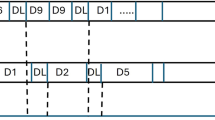Abstract
In this paper, we propose a statistical Call Admission Control (CAC) schemes for single and multi-hop IEEE 802.11 based wireless ad hoc networks. Unlike most papers which consider average end-to-end delay, our algorithm guarantees statistical delay that would be more efficient for real time multimedia applications. We use Effective Bandwidth/Effective Capacity theory to compute delay bound stochastically in each hop. The proposed distributed CAC algorithm is suitable for ad hoc networks. Also, with a few changes, it has been implemented in the AODV routing protocol. Simulation results demonstrate that proposed CAC algorithm works efficiently in both single and multi-hop networks. Moreover, we investigated our algorithm with aggregated traffic and the result shows that the algorithm performed accurately under that condition.













Similar content being viewed by others
References
Sarkar, S. K., Basavaraju, T., & Puttamadappa, C. (2007). Ad hoc mobile wireless networks: Principles, protocols, and applications. Boca Raton: CRC Press.
IEEE Std 802.15.4-2011. (2011). IEEE standard for local and metropolitan area networkspart 15.4: Low-rate wireless personal area networks (lr-wpans). Revision of IEEE Std 802.15.4-2006, 1314. doi:10.1109/IEEESTD.2011.6012487
IEEE Std 802.11-2007. (2007). IEEE standard for information technology—Telecommunications and information exchange between systems—local and metropolitan area networks—specific requirements—part 11: Wireless lan medium access control (MAC) and physical layer (PHY) specifications. Revision of IEEE Std 802.11-1999, 11076. doi:10.1109/IEEESTD.2007.373646
Wu, D., & Negi, R. (2003). Effective capacity: A wireless link model for support of quality of service. IEEE Transactions on Wireless Communications, 2(4), 630643. doi:10.1109/TWC.2003.814353.
Hanzo, L, I. I., & Tafazolli, R. (2009). Admission control schemes for 802.11-based multi-hop mobile ad hoc networks: A survey. IEEE Communications Surveys Tutorials, 11(4), 78108. doi:10.1109/SURV.2009.090406.
Khoukhi, L., Badis, H., Merghem-Boulahia, L., & Esseghir, M. (2013). Admission control in wireless ad hoc networks: A survey. EURASIP Journal on Wireless Communications and Networking. doi:10.1186/1687-1499-2013-109
Abdrabou, A., & Zhuang, W. (2008). Stochastic delay guarantees and statistical call admission control for IEEE 802.11 single-hop ad hoc networks. IEEE Transactions on Wireless Communications, 7(10), 39723981. doi:10.1109/T-WC.2008.070564.
Zhao, Q., Tsang, D., & Sakurai, T. (2011). A simple critical-load-based cac scheme for ieee 802.11 dcf networks. IEEE/ACM Transactions on Networking, 19(5), 14851498. doi:10.1109/TNET.2011.2116801.
Bensaou, B., Kong, Z.-N., & Tsang, D. (2008). A measurement-assisted, model-based admission control algorithm for IEEE 802.11e. In International symposium on parallel architectures, algorithms, and networks, 2008. I-SPAN 2008, pp. 260–265. doi:10.1109/I-SPAN.2008.44
Cai, L., Shen, X., Mark, J. W., Cai, L., & Xiao, Y. (2006). Voice capacity analysis of wlan with unbalanced traffic. IEEE Transactions on Vehicular Technology, 55(3), 752761. doi:10.1109/TVT.2006.874145.
Cheng, Y., Ling, X., Song, W., Cai, L., Zhuang, W., & Shen, X. (2007). A cross-layer approach for wlan voice capacity planning. IEEE Journal on Selected Areas in Communications, 25(4), 678688. doi:10.1109/JSAC.2007.070505.
Chen, X., Zhai, H., Tian, X., & Fang, Y. (2006). Supporting qos in ieee 802.11e wireless lans. IEEE Transactions on Wireless Communications, 5(8), 22172227. doi:10.1109/TWC.2006.1687738.
Kafetzakis, E., Kontovasilis, K., & Stavrakakis, I. (2012). A novel effective capacity-based framework for providing statistical qos guarantees in IEEE 802.11 WLANs. Computer Communications, 35(2), 249–262. doi:10.1016/j.comcom.2011.09.012. URL http://www.sciencedirect.com/science/article/pii/S0140366411002982
Perkins, C., & Royer, E. (1999). Ad-hoc on-demand distance vector routing. In: Proceedings 2nd IEEE workshop on mobile computing systems and applications, 1999. WMCSA 99, 1999, pp. 90–100. doi:10.1109/MCSA.1999.749281
Haq, M., Matsumoto, M., Bordim, J., Kosuga, M., & Tanaka, S. (2004). Admission control and simple class based qos provisioning for mobile ad hoc network. In IEEE 60th vehicular technology conference. VTC2004-Fall, Vol. 4, pp. 2712–2718. doi:10.1109/VETECF.2004.1400551
Gharehajlu, M.M., Zokaei, S., & Darmani, Y. (2015). Statistical analysis of different traffic types effect on qos of wireless ad hoc networks. Journal of Information Systems and Telecommunication, 3(1).
Angrishi, K. (2013). An end-to-end stochastic network calculus with effective bandwidth and effective capacity. Computer Networks 57(1), 78–84. doi:10.1016/j.comnet.2012.09.003. URL http://www.sciencedirect.com/science/article/pii/S1389128612003258
Kelly, F., Zachary, S., & Ziedins, I. (1996). Stochastic networks: Theory and applications. Oxford: Oxford University Press.
Chang, C.-S., & Thomas, J. (1995). Effective bandwidth in high-speed digital networks. IEEE Journal on Selected Areas in Communications, 13(6), 1091 1100. doi:10.1109/49.400664.
Courcoubetis, C., & Weber, R. (1995). Effective bandwidths for stationary sources.
Jiang, Y., & Liu, Y. (2008). Stochastic network calculus. New York: Springer.
Network SimulatorNS (Version 2). URL: http://www.isi.edu/nsnam/ns/
Author information
Authors and Affiliations
Corresponding author
Appendices
Appendix 1: Proof of Proposition 1
In Eq. (10) \(D_{EE}(t)\) is equal to:
By substituting (15) in (8) and supposing \(\gamma (\lambda )\approx 1\) we have:
Now if we suppose \(\theta _i^c(\lambda _i)*\lambda _i\) is equal to the minimum of QoS exponent in the path, namely equal to (11), (16) is given by:
In homogeneous networks we assume that the delay in all hops are the same and equal to \(\frac{D_{max}}{H}\), the upper bound in multi-hop network is yield to:
So the proposition is proven.
Appendix 2: Flowchart of CAC algorithm
In this appendix, the flowcharts of the implemented algorithm in NS2 are represented. Figures 15, 16 and 17 show the modified RREQ function, the implemented RREP function and the modified receive function in NS2 for our CAC algorithm, respectively (Fig. 14).
Rights and permissions
About this article
Cite this article
Mollaei, M., Darmani, Y. A novel statistical and distributed CAC algorithm for IEEE 802.11 based single and multi-hop wireless ad hoc networks. Wireless Netw 24, 955–967 (2018). https://doi.org/10.1007/s11276-016-1387-8
Published:
Issue Date:
DOI: https://doi.org/10.1007/s11276-016-1387-8








